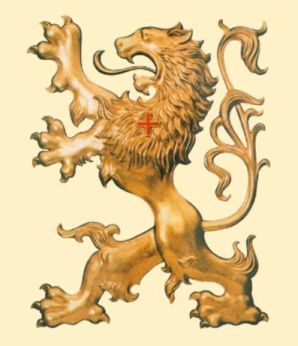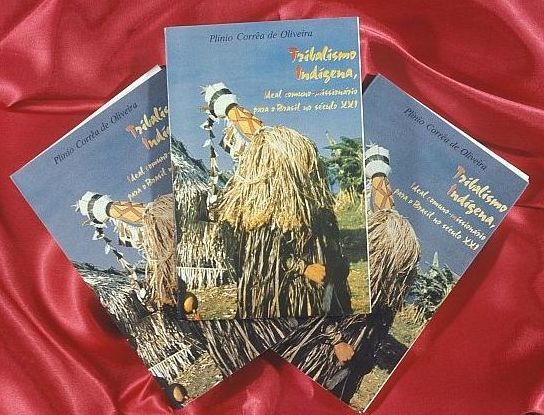|
Plinio Corrêa de Oliveira
Indian Tribalism: The Communist-Missionary Ideal for Brazil in the Twenty-First Century
Translated and adapted by the American TFP, without the Author's revision |
|
|
Tribalismo indígena, ideal comuno-missionário para o Brasil no século XXI, São Paulo, Editora Vera Cruz, 1977. New caravans of the TFP, visiting 2,963 cities, distributed 76,000 copies of the book printed in seven successive editions. Contents What’s the Agenda? A Look at a Tribal Future PART I - The Traditional Catholic Concept of the Missions 1. Concept of the Mission 2. The Highest End of the Mission: Essentially Religious - the Glory of God and Eternal Happiness 3. Effects of the Mission in Temporal Life a) Order b) The Greatness and Well-Being of Nations 4. The Mission and the Indians a) Contact with Jesus Christ b) Contact with Modern Neo-Paganism c) A Troubling Problem 5. An Impossible Solution for the Missionary: To Do Nothing a) The Power of Our Lord Jesus Christ Over Upright Souls b) Contact With Western Civilization c) Influence of the True Priest d) A Futile Problem e) The Communist Agitator, the Missionary of Satan PART II - The “Aggiornata” and Progressive Conception of the Missions 1. Main Goal of “Aggiornata” Missiology: A New Order for Temporal Society 2. What is the New Order Sought by the “Aggiornata” Missiology? Inversion of Values Between the Individual and Society Egoism Generates an Unjust Society 3. Man and Egoism: The Contrast Between Traditional Teaching and Neomissiology a) Man Has an Immediate End in Himself and a Transcendent End in God b) For Neomissiology, Man is Like a Part That Lives for the Whole c) People and Mass, in the Description of Pius XII 4. Egoism and Contemporary Society a) The Great Babels Born From Modern Technology b) False Solution of the "Aggiornata" Missiology 5. “Abyss Calleth on Abyss”: From the Exacerbation of Egoism, Contemporary Society has Reached Collectivism a) Confusion Between Person and Egoism b) Communist Conception 6.The New Abyss Leads to a Third: From Communism to Anarchy a) Neo-Communism Seeks the Dismantling of the State b) The “Classical” Communist Already Foresaw This “Evolution” 7. “Aggiornata” Missiology in the Brazilian Jungle a) Tribal Organization, a Masterpiece of Anthropological Wisdom b) Tribal Life and Communist Society c) Are the Indians Communists? 8. Neo-Tribal Conceptions With Respect to the Family a) Uninhibited Superficiality and Enigmatic Parsimony b) The Free-Love Community, Corollary of the Community of Goods 9. To Catechize is Secondary and Even Superfluous a) Goals of the “Updated” Missionary: To Free the Indian From the “Contagion” of Civilization - “Conscientization.” b) The “Error” of the Missionaries and the Colonizers 10. Scope of This Study a) New Missiology and “Structuralism” b) In Discussing the Indians, They Prepare for the Advent of the Communist Society 11. Catechesis and Agitation a) Should We Waste Time Studying These Irrational Daydreams? b) Absurdities That Wither and Absurdities That Thrive c) A Bishop Declares Himself Transcommunist d) How Could This Philosophy Steal Into the Church? e) The Church and the Country Imperiled PART III - “Aggiornate” Missionary Voices Section I - Community of Goods 1. “The Indians Already Live the Beatitudes. They Do Not Know of Private Property, Profit, Competition” 2. Praise For the Tribal System’s Community of Goods - Invectives Against Private Property 3. Disparagement of One’s Country and Eulogy of Tribal Collectivism 4. A “New Church” of Communist Inspiration, Where Property Is Heresy and the Proprietor Is a Heretic. 5. Private Property Presented as the Source of All Evils 6. The Communist View of Charity Section II - Tribal Life in Nonsavage Conditions 7. Longings for the Tribal Primitivism of Our Indians 8. Utopia, Yes; But the Ideal Towards Which One Should Ever Tend 9. Primitive Societies Are Closer to the Ideal. 10. Eulogy of Indian Nudity, “Global and Natural” Section IV - Idyllic and “Evangelical” Description of Indian Life 11. A Tribal Paradise, Where Ownership of the Means of Production Is Collective and Authority Does Not Exist 12. “Without Losing Their Communitarian, Religious, and Tribal Values” 13. “We Have Only to Learn From the Indians” 14. Indians Are Models For Our Society 15. The “Aggiornata” Missiology Inspires a Radical Transformation of Our Society 16. Mission of the Indian: “To Help the Civilized Rediscover Civilization” Section V - Evangelization is Not Necessary 17. Living In a Communitarian Regime, the Indians Do Not Need a Church 18. The Main Purpose of the Church Is Not to Convert the Indians to the Religion of Jesus Christ But to Preserve Their Tribal State 19. The Updated Catechesis: To Bring to the Surface the Religious Message That the Indian Carries in His Subconscious 20. Evangelization Is Secondary for Missionaries Who Disparage the Work of Anchieta 21. The Indian Peoples Are the True Evangelizers of the World 22. The Indian Cannot Be Considered as Having Undesirable Psychic and Cultural Characteristics 23. A Surprising “Scientific” Catechesis 24. Catechesis, What for? 25. Almost Hopeless Catechesis 26. “Without Any Intention of Catechizing” 27. Errors of the Missionaries: Teaching Shame For Nudity, the Use of Clothes, and the Rejection of Collective Life in the Village 28. The Traditional and Progressivist Catechist Faced With the Abominations and Crimes of the Savage 29. The Church: Accomplice of Colonialism Until John XXIII Section VII - Striking At Civilization 30. The Methods of Anchieta and Nobrega Allegedly Caused the Dissolution and Death of the Indians 31. Understanding Medicine Is No More Valuable Than Knowing How to Make Dye From Genipap 32. The Price of Each Step of Our Progress Is the Ruin of One More Tribe 33. “See How They Are: They Are Ashamed of Their Own Bodies and Cover Their Skin.” Section VIII - The Indian, the Only Proprietor 34. The American Indian Is the Only True Lord of the Land 35. “The Indians Are the First Owners of Brazilian Land.” Section IX - The Indian Question, Fuse of an Agrarian Crisis in the Country 36. Indians and Small Land-Holders Should Endeavor to Promote Rural Agitation 37. Using the Case of Meruri to Ask “Radical Agrarian Reform” Throughout the Country 38. The Solution of the Indian Problem Requires “A Radical and Profound Transformation of the Brazilian Agrarian Structure” Section X - Struggle Against the Whites 39. Christian Whites Came to Dominate, Despise, Plunder, and Degrade the Indian 40. Anchieta, a Colonialist Agent? 41. Our Lady of Victories, No; Our Lady of Misfortune 42. The Indian: A Living Contestation of Capitalism and Christian Civilization 43. The Missionaries See in the Indians a Prophetic Sign to Put Into Question the Church and Society Section XI - Attack on the Pioneers 44. Pioneers, the Greatest Predators and Indian Killers 45. Discoverers and Pioneers: Malefactors Section XII - “Independence or Death” Proclaimed in Brazil—Against Brazil 46. Indian Declaration of Independence From Brazil? 47. The Indian, Raw Material for Communist Agitation? Section XIII - To Meddle With Bishop Casaldaliga… 48. Craters in the Jungles, Sparks in the Cities |
|


